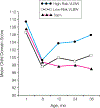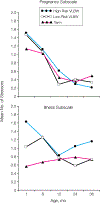Maternal psychological distress and parenting stress after the birth of a very low-birth-weight infant
- PMID: 10071000
- PMCID: PMC10189739
- DOI: 10.1001/jama.281.9.799
Maternal psychological distress and parenting stress after the birth of a very low-birth-weight infant
Abstract
Context: Few studies document how parents adapt to the experience of a very low-birth-weight (VLBW; <1500 g) birth despite societal concerns about the ethics and justification of intensive care for these infants.
Objective: To determine the degree and type of stress experienced over time by mothers whose infants vary in degree of prematurity and medical and developmental risk.
Design: Longitudinal prospective follow-up study of a cohort of mothers of high- and low-risk VLBW and term infants from birth to 3 years.
Setting: All level III neonatal intensive care units from a large midwestern metropolitan region.
Participants: Mothers and infants prospectively and consecutively enrolled in a longitudinal study between 1989 and 1991. High-risk VLBW infants were diagnosed as having bronchopulmonary dysplasia, and comparison groups were low-risk VLBW infants without bronchopulmonary dysplasia and term infants (>36 weeks, >2500 g).
Main outcome measures: Standardized, normative self-report measures of maternal psychological distress, parenting stress, family impact, and life stressors.
Results: Mothers of VLBW infants (high risk, n = 122; low risk, n = 84) had more psychological distress than mothers of term infants (n=123) at 1 month (13% vs 1%; P = .003). At 2 years, mothers of low-risk VLBW infants did not differ from term mothers, while mothers of high-risk infants continued to report psychological distress. By 3 years, mothers of high-risk VLBW children did not differ from mothers of term children in distress symptoms, while parenting stress remained greater. Severity of maternal depression was related to lower child developmental outcomes in both VLBW groups.
Conclusions: The impact of VLBW birth varies with child medical risk status, age, and developmental outcome. Follow-up programs should incorporate psychological screening and support services for mothers of VLBW infants in the immediate postnatal period, with monitoring of mothers of high-risk VLBW infants.
Figures




References
-
- Ventura SJ, Martin JA, Curtin SC, et al. Report of Final Natality Statistics: 1996 Supplement. Hyattsville, Md: National Center for Health Statistics; 1997:1–84. - PubMed
-
- McCormick MC, Brooks-Gunn J, Workman-Daniels K, Turner J, Peckham GJ. The health and developmental status of very low-birth-weight children at school age. JAMA. 1992;267:2204–2208. - PubMed
-
- McCormick MC, Workman-Daniels K, Brooks-Gunn J. The behavioral and emotional well-being of school-age children with different birthweights. Pediatrics. 1996;97:18–25. - PubMed
-
- Klein NK, Hack M, Breslau N. Children who were very low birth weight: developmental and academic achievement at nine years of age. J Dev Behav Pediatr. 1989;10:32–37. - PubMed
Publication types
MeSH terms
Grants and funding
LinkOut - more resources
Full Text Sources
Medical

